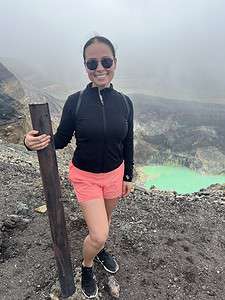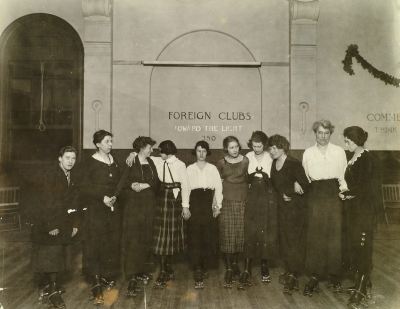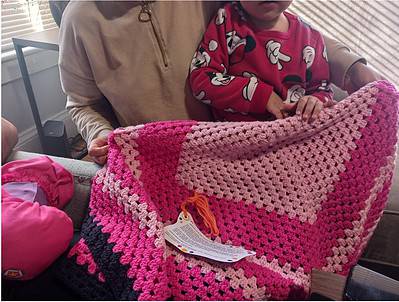1924-1934: Fostering Community
“100 Years of Welcome: Commemorating IINE’s Boston Centennial” Series:
Installment #2
Welcome to the second installment of our series, “100 Years of Welcome: Commemorating IINE’s Boston Centennial.” You can find the first installment, which described an immigration boom that bolstered the factory economy in Boston from 1910-1924 and the formation of International Institutes across the country, here: “1910-1924: Redefining Americanism.” We pick back up where we left off – in 1924, the year of the founding of the International Institute of Boston.
In this period, the newly formed International Institute of Boston (IIB) provided a space to celebrate and support the city’s immigrant communities during a period of restricted immigration and economic hardship.
Navigating Troubled Waters
The International Institute of Boston was founded at Boston’s YWCA in 1924 as part of a national movement of International Institutes that promoted the then radical practice of integration without forced assimilation.
Leading up to the founding, the YWCA had placed a focus on helping newly arrived immigrant women obtain citizenship at a time when tens-of-thousands of immigrants were arriving at Boston Harbor each year, often filling jobs in newly built factories. By 1924, the tide had turned as immigration slowed due to discriminatory federal laws, and soon after, the Great Depression would shutter many of the factories and businesses that had employed new Bostonians during the prior immigration boom.
And yet, Boston was still very much a city of immigrants. According to the 1930 federal Census, more than 60% of Boston’s residents were either born outside of the U.S. or both of their parents were. The International Institute of Boston and its supporters were dedicated to helping them remain and thrive.
From the mid-1920s to mid-1930s, the International Institute led the charge in pushing back against efforts to detain and deport immigrants, urging supporters to write to their congressmen to voice their steadfast support for their new community members. While offering the core services still provided today—advocacy, access to education, jobs, healthcare, and immigration legal assistance—the International Institute of Boston also focused on supporting persecuted immigrants in exploring, expressing, and drawing strength from the cultural heritages they brought to Boston, shaping the character of our city.
Bringing Communities Together in A Vibrant New Home

In 1930, the International Institute moved from the YWCA on 12 Newbury Street, to offices at 190 Beacon Street, within walking distance of Boston Common, the Massachusetts State House, and what would become the International Institute of New England’s current Boston office on 2 Boylston Street. This building would be the home of the International Institute of Boston until 1964.
It was here that the agency first expanded its client population to include men and boys as well as women and girls. In addition to providing case work in Boston’s neighborhoods, the International Institute also continued expanding its social and cultural programming. The first staff of the International Institute of Boston included two professional “Secretaries” (as all staff members were called) who were “nationality workers.” Themselves immigrants, these staff provided case work and organized cultural programming for Boston’s new Armenian, Russian, Greek, and Polish communities. A Syrian Secretary and an Italian Secretary were added within the next two years.
With this team of nationality workers, the agency began facilitating educational, social, and cultural programs. They helped a group of Armenian women found The Women’s Gertasiratz School to both learn English and teach Armenian to their children, organized an Armenian social club, and helped form a Polish Students Club to study Polish language and culture.
These programs, and the many that would follow, helped first-generation immigrant groups to connect and form tight-knit communities and helped second-generation Americans—many of whom were torn between their families and the pressure to assimilate—to stay connected to their culture and communities in a time when they needed to pull together for support.

In the 1930’s, The International Institute of Boston sponsored an Italian Girls Club to teach Italian language and literature, which the agency’s Italian Secretary hoped would “give the girls a sense of pride in acknowledging the greatness of their ancestry,” and it sponsored an organization to study Greek language and history and produce Greek plays; a Syrian Girls Club to study Arabic; a Syrian Mothers Club offering both lectures and songs in the Arabic language; and a club for the study of Russian literature. Czech immigrants gathered for lectures on Czech history, Finnish immigrants came for musical programs, and Ukrainians gathered for folk dancing and singing.
Through the struggles of discriminatory policies and the economic depression, these clubs and classes brought immigrants together to draw strength from one another, build solidarity and leadership, and practice artistic expression that would not only carry on their traditions but also help them share their cultures with their new neighbors.
Echoes of the social clubs sponsored by the International Institute of Boston 100 years ago are felt in today’s sewing and cooking groups IINE has formed for recently arrived Afghan women targeted by the Taliban, and in our Suitcase Stories® program through which refugees, immigrants and second-generation Americans perform tell their personal stories of migration and new beginnings.
The International Beacon

In 1933, the International Institute of Boston launched The International Beacon, a newsletter that kept membership current on its programming and on the pressing immigration issues of the day and how to advocate for immigrant rights. Its first editor, Alfrieda Mosher, was the daughter of a U.S. diplomat and a graduate of Boston University who spoke several European languages. Long a champion of immigrants, Mosher had volunteered at the YWCA to help immigrant women with citizenship and naturalization issues, and had led clubs for Anglo-American, Swiss, French, and Armenian women. She was a natural spokesperson to celebrate the agency’s work and call its members to action.
Today, maintaining its beacon of welcome to refugees and immigrants, the International Institute of New England and its supporters carry the passion and dedication of its founders to the core services that new Bostonians need to integrate and thrive. Over 100 years, we have continued to weather dramatic changes in immigration policy and shifts in the perception of newcomers beyond our control, focusing our services in response to the needs of the individuals and families that we serve. As the International Institute’s earliest nationality workers understood, immigrants are vital to the framework of Boston – and with initial support, they become well-positioned to reach their full potential in our communities.
During our centennial year, we celebrate 100 years of life-changing support to refugees and immigrants in Greater Boston and prepare for our second century of service. Learn more here: IINE Boston Centennial.



 Born and educated as a trained physician in Italy, Giovanni joined Bristol Myers Squibb in 2000, assuming a number of roles over the years, most notably as CEO and today, as the Executive Chairman of the Board. At the Golden Door Award gala, Giovanni’s colleagues, including Vicki Sato, Chair, Denali Therapeutics and VIR Biotechnology, and Ted Samuels, Lead Independent Director, Bristol Myers Squibb, paid tribute to his impactful leadership, which has led to the development of medicines that have fundamentally changed the way we treat cancer; his commitment to developing a patient-focused culture driven by innovation and accountability; and his strong belief in the business value of diversity and inclusion.
Born and educated as a trained physician in Italy, Giovanni joined Bristol Myers Squibb in 2000, assuming a number of roles over the years, most notably as CEO and today, as the Executive Chairman of the Board. At the Golden Door Award gala, Giovanni’s colleagues, including Vicki Sato, Chair, Denali Therapeutics and VIR Biotechnology, and Ted Samuels, Lead Independent Director, Bristol Myers Squibb, paid tribute to his impactful leadership, which has led to the development of medicines that have fundamentally changed the way we treat cancer; his commitment to developing a patient-focused culture driven by innovation and accountability; and his strong belief in the business value of diversity and inclusion. 












 The first International Institute was established by Edith Terry Bremer in New York in 1911 under the sponsorship of the local Young Women’s Christian Association (YWCA), A graduate of the University of Chicago, Bremer had extensive social services experience and had worked as a Special Agent for the United States Immigration Commission. At the YWCA, she administered a survey on the status of immigrant women in the city and learned how great their needs were. In response, she founded the International Institute to provide immigrant girls and women with English language classes and recreational and club activities, and to support them with housing, employment, and citizenship.
The first International Institute was established by Edith Terry Bremer in New York in 1911 under the sponsorship of the local Young Women’s Christian Association (YWCA), A graduate of the University of Chicago, Bremer had extensive social services experience and had worked as a Special Agent for the United States Immigration Commission. At the YWCA, she administered a survey on the status of immigrant women in the city and learned how great their needs were. In response, she founded the International Institute to provide immigrant girls and women with English language classes and recreational and club activities, and to support them with housing, employment, and citizenship. 











 My name is Anastasiia Kadzevych and I’m from Ukraine. Before the war started I lived happily in my native city – Odesa. Since my teen years, I was really fond of fashion. While graduating from the Odesa National University, I started to build my true bond with fashion, and finally, when I got my master’s degree in economics I realized that my true passion is fashion and that I want to make it my job.
My name is Anastasiia Kadzevych and I’m from Ukraine. Before the war started I lived happily in my native city – Odesa. Since my teen years, I was really fond of fashion. While graduating from the Odesa National University, I started to build my true bond with fashion, and finally, when I got my master’s degree in economics I realized that my true passion is fashion and that I want to make it my job. 